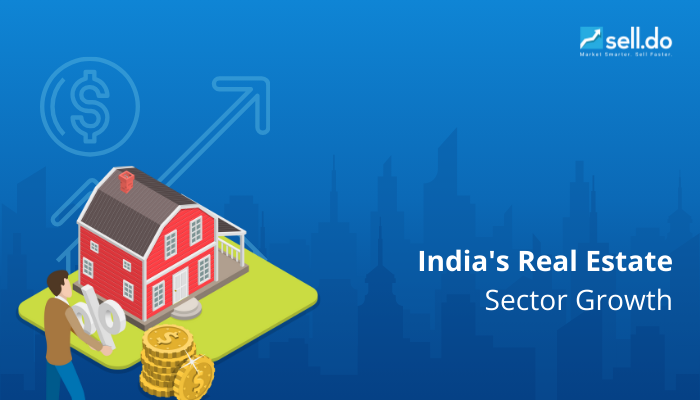The real estate growth in India is unrivaled, with the market expected to expand to $5.8 trillion by 2047, contributing 15.5% to the GDP from an existing share of 7.3%. The sector supports India’s growing urban needs and has become the backbone of the nation's infrastructure.
Moreover, the growth of the corporate sector has led to a higher need for commercial centers and housing projects, paving the way for rapid urbanization. Despite facing challenges from the COVID-19 pandemic, the sector's ability to bounce back firmly has solidified its importance in India's economic future.
Today, let’s explore the market size of real estate in India to understand the sector’s economic role and future potential for stakeholders.
Real Estate Market Size in India

India’s real estate market is set for significant expansion, projected to grow from $332.85 billion in 2025 to $985.80 billion by 2030, with a CAGR of 24.25%. This rapid growth highlights the sector’s increasing demand, investment potential, and evolving opportunities.
- Market Growth: India's real estate market, valued at approximately $477 billion in 2022, is set to grow significantly, reaching $1 trillion by 2030 and expanding further to $5.8 trillion by 2047. This growth is expected to increase the sector's GDP contribution from 7.3% to 15.5%.
- Residential Property Surge: In FY23, home sales reached a record high of Rs. 3.47 lakh crore (US$42 billion), up 48% from the previous year. Among real estate segments, residential real estate dominates, with a projected market volume of $40.20 trillion in 2025, highlighting the sector’s strong growth and demand.
- Urban Development: Demand for residential properties in the top eight Indian cities surged, especially in the mid-income, premium, and luxury segments, despite high mortgage rates and property prices.
- Retail Expansion: Between 2024 and 2028, nearly 41 million sq. ft. of retail space will become operational across the top seven cities.
- Commercial Leasing: Gross leasing in the top seven markets reached a record 62.98 million sq. ft. in 2023, a 26.4% increase.
- Data Center Demand: The real estate demand for data centers will increase by 15-18 million sq. ft. by 2025.
- Office Space: In 2023, office absorption in the top seven cities was 41.97 million sq. ft.
- Fresh Real Estate Launches: In the first quarter of 2023, new releases in the leading seven cities accounted for 41% of the market share. More than 41% of the 1.14 lakh units sold were new releases.
- Housing Shortage: Urban areas face a projected deficit of 10 million housing units. By 2030, an extra 25 million affordable housing units will be required to house the increasing urban population.
Although the real estate growth in India is consistent, the COVID-19 pandemic caused it to suffer greatly, resulting in a substantial economic loss. However, the crisis also caused the sector to adopt new trends to align with the latest market demands.

Adapting to Industry Changes: The Adaptive Power of CRM for Real Estate Brokers in 2024
Impact of COVID-19 on Indian Real Estate
Real estate growth in India came to a standstill due to the COVID-19 pandemic, leading to extensive disturbances and economic setbacks. Nevertheless, the sector rapidly bounced back and regained traction once the situation normalized.
Initial Setbacks (2020-2021)
- The pandemic brought the Indian property market to a standstill, leading to an estimated loss of over ₹1 lakh crore.
- Residential demand plummeted by 40% in the first half of 2021 compared to the previous year.
- Home sales in seven major cities dropped sharply, falling to 1.38 lakh units in 2020, down from 2.61 lakh units in 2019.
Subsequent Recovery
The real estate boom in India began in the second half of 2021, driven by strategic adaptations and renewed buyer interest.
- Sales rebounded significantly, reaching 2,32,903 units by the end of 2021, marking a 51% year-on-year increase.
- The second half of 2021 recorded an all-time high, with 41% year-on-year sales growth, highlighting the sector's strong recovery and resilience.
- Post-pandemic, India emerged as one of the few markets in the Asia-Pacific (APAC) region with positive office absorption. It accounts for 37% of APAC office demand, with ~21 million sq. ft. of office space absorbed.
Furthermore, with an increase in office space requests starting in Q3 2021, tenants began to move forward with both immediate lease requirements and long-term growth strategies for the upcoming 3–4 years. As vaccination rates increase, there has been a rise in office leasing activities as many organizations are speeding up their return-to-work (RTW) schedules and growth plans.
Next, let’s look at the factors that led to the real estate boom in India.

Future-proofing Real Estate: Anticipating Trends with CRM in 2024
Factors Driving Real Estate Growth (2022-2032)

Interest rates, government regulations, and significant technological advancements are key factors contributing to the growth of the real estate market in India. These elements impact the relationship between demand and supply, creating opportunities for new developments and investments in the industry.
-
Expansion in Market Size
India’s real estate market is projected to reach $46.76 trillion by the end of 2025 and $1 trillion by 2030, with exponential growth expected through 2047. The demand for residential, commercial, and industrial spaces continues to rise, driven by urban expansion, population growth, and increasing incomes. While India’s market is expanding rapidly, the United States leads globally, with a projected real estate market value of $136.6 trillion in 2025.
The demand for residential, commercial, and industrial spaces will drive further growth in the real estate market. Rising population, urban growth, and rising incomes have fueled this growth, boosting new projects and property deals.

-
Boom in Luxury and Commercial Real Estate
Individuals with high net worth seek premium properties offering exclusive, state-of-the-art amenities. This has given rise to a luxury segment catering to the demand for high-quality assets representing the individual’s lifestyle. Commercial real estate also sees a boom as the IT industry, startups, and MNCs seek modern office spaces, driving demand in this sector.
- Affordable housing sales (under ₹50 lakh) fell from 32% to 27% due to rising costs and pandemic effects.
- Luxury homes (over ₹1 crore) increased to 41% of total sales, driving 11% year-on-year market growth.
- Mid-segment housing (₹50 lakh to ₹1 crore) declined from 38% to 32%, likely a temporary correction.
-
Urbanization and Demographic Shifts
The urban population in India is expected to rise by 416 million by 2050. This urban growth drives high demand for housing, commercial spaces, and infrastructure. Due to increased urban migration for improved jobs and increased quality of life, nuclear households are on the rise.
Additionally, urban areas require substantial additional residences, large-scale business establishments, and updated public utilities to accommodate the growing population. The increase in need is changing the real estate sector in India, causing developers and investors to prioritize creative, eco-friendly, and cost-effective options.
-
Infrastructure Development
Government efforts to improve infrastructure have a notable effect on the growth of the real estate sector. Initiatives such as expanding metro rail systems, upgrading road infrastructure, and developing smart cities increase connectivity and accessibility, making regions more appealing for real estate investmen
-
Foreign Investments
Global investors are drawn by the relaxation of foreign direct investment (FDI) norms and attractive returns. These investments bring in capital and expertise, boosting the development of high-quality projects and further fueling market growth.
-
Lifestyle Options
The desire for comprehensive lifestyle projects is rising as buyers seek self-sustaining communities that incorporate housing, business, and leisure facilities within one complex. These neighborhoods are popular because they offer a convenient and well-rounded living experience.
-
Real Estate as a Potential Investment
Real estate remains a favored investment option due to its potential for stable returns and capital appreciation. Investors view it as a safe asset class that can hedge against inflation and economic uncertainties, sustaining interest and investment in the sector.
-
Emerging Real Estate Hotspots
Improved infrastructure, strategic locations, and government incentives drive new real estate hotspots. These hotspots offer attractive investment opportunities, further fueling the real estate market's growth.
-
Interest Rates, Government Policies, and Technological Advancements
Low interest rates simplify financing for homebuyers, driving demand for properties. Favorable government policies, such as tax incentives and property management regulations, actively shape the market. Additionally, technological advancements like virtual property tours and smart home technology enhance the market's effectiveness, transparency, and appeal.
As discussed above, government policies and reforms directly influence real estate growth and can reshape the sector. With that in mind, let’s explore the regulatory changes and policies that helped revive and grow India's real estate sector.
Policy Reforms and Regulatory Environment

Because of significant policy reforms and regulatory changes, India's real estate market has recovered and multiplied post-pandemic. These measures have been fundamental in shaping the sector and promoting transparency, efficiency, and growth.
Real Estate (Regulation and Development) Act (RERA):
The Indian government launched RERA in March 2016 to enhance transparency and accountability in the real estate sector. It guarantees the protection of homebuyers' interests by ensuring timely delivery and project quality and offering a rapid resolution for disputes. Below are some of the critical measures implemented in 2024:
- Share detailed information about the amenities, including location, size, and whether developers should mention the Floor Space Index (FSI).
- Provide buyers with handover dates for common areas.
- Get prior consent for any significant changes to amenities or common areas.
- Include parking details, such as space dimensions and location, in the sale agreement.
- Developers must mention non-negotiable clauses regarding amenities in the Agreement for Sale, following the specified format.
- Categorize amenities as utilizing a 'free of FSI' area or project FSI under local planning rules.
- Ensure that the list of amenities aligns with the information provided in the registration forms and architect certificates.
These measures seek to enhance transparency, accountability, and buyer protection.
Amendment to the Benami Transactions Act
The 2016 amendment made the Benami Transactions (Prohibition) Act more effective in combating black money and corruption. This law targets deceitful property purchases made under fictitious names. The amendment has enhanced enforcement, resulting in a cleaner and more transparent real estate market.
Some of the most recent changes include:
- 3-Month Deadline for Responses: Authorities will give benamidars or Beneficial Owners a 3-month deadline to respond to Show Cause Notices.
- Extended Provisional Attachment Period: The authorities have extended the provisional attachment period from 90 days to 4 months to give more time for investigation.
- Extended Referral Period: The period for referring cases to the Adjudicating Authority has been extended from 15 days to one month.
- Immunity for Benamidars: Initiating Officers can grant immunity from penalties to benamidars who fully disclose details of the Benami transaction.
Goods and Services Tax (GST)
Launched on July 1, 2017, GST simplified the tax structure for homebuyers by replacing multiple taxes with a single tax. This reform made homebuying more straightforward and reduced the overall tax burden on buyers, thus increasing affordability and boosting the real estate market. The key updates for 2024 include:
- Revised GST Rates for Commercial Properties: To boost investment in commercial real estate, the GST rate for under-construction commercial properties has been reduced from 18% to 15%.
- Rationalization of ITC Provisions: New provisions have been introduced to streamline the ITC claims process, allowing developers to claim ITC more efficiently with proper documentation. This is expected to lower construction costs, benefiting both developers and buyers.
- Introduction of E-Invoicing: In 2024, e-invoicing was expanded to include real estate transactions. All sales of under-construction properties must now be reported through the e-invoicing system, improving transaction tracking and ensuring better compliance with GST laws.
If you’re looking for a platform that streamlines payments by enabling customers to browse, negotiate, and purchase properties securely online, explore Sell.Do! Our integrated CRM solution for developers and brokers offers features that help you manage transactions and integrate loan bank accounts to simplify the buying process for both, you and your customers.

Unlocking the Secrets to Real Estate Sales Success: Essential Pre-Sales Strategies
Permanent Residency Status for Foreign Investors
To attract foreign investments, the Indian government offers permanent residency status to foreign investors for ten years, provided they meet specific criteria. This policy has attracted significant foreign capital, further strengthening the property market.
Foreign Direct Investment (FDI) in Real Estate
Foreign investment in Indian real estate surged, with inflows tripling to $23.9 billion between 2017 and 2021, compared to the previous five years. The share of foreign investments grew to 82% during this period.
The relaxation of FDI regulations has allowed international investors to enter India's real estate market. Moreover, enabling foreign direct investment through the automatic route has implemented global standards and attracted significant foreign investment, fueling progress and advancement.
Key Drivers for Foreign Direct Investment:
- Demand for Grade A Office Space: Increased demand from multinational and Indian corporations has boosted the need for high-quality office spaces.
- FDI Policy Relaxation: The 2014 government reforms reduced minimum area and capital requirements and allowed more accessible exits, making it more attractive for foreign investors.
- Prop-Tech Growth: The rise of e-commerce and logistics has fueled investment in industrial and logistics assets, drawing significant foreign capital.
- REITs Appeal: Real Estate Investment Trusts (REITs) offer low-risk investment, capital appreciation, and easy exit options, making them a popular choice for foreign investors.
Simply put, the legislative improvements in the real estate sector in India have had a substantial effect, resulting in increased openness, accountability, and efficiency.
Infrastructure Status to Affordable Housing
Giving infrastructure rank to affordable housing has helped India's real estate market get cheaper loans, better tax breaks, and more investments. This action has motivated developers to concentrate on creating affordable housing, ensuring that homeownership is within reach for low and middle-income individuals.
- Increased Allocation: In Budget 2024-25, PM Awas Yojana Urban 2.0 aims to address housing needs for 1 crore urban poor and middle-class families with a ₹10 lakh crore ($120.16 billion) investment, further accelerating housing development.
- SWAMIH Fund: The SWAMIH fund supports stalled affordable housing projects, addressing supply issues and reviving demand.
- High Demand: Affordable housing drove over 50% of real estate demand in 2021, and an expected Rs 45 trillion investment opportunity is expected in the next 4-5 years.
Due to growing government support and market demand, developers, suppliers, and housing finance companies have substantial opportunities. Policy reforms and regulatory changes have increased transparency and efficiency in the real estate industry while creating a favorable environment for investors, paving the way for long-term growth.
With a clear understanding of these reforms, let’s explore real estate trends in India to help you gain valuable insights, make informed decisions, and achieve long-term success.

Challenges And Opportunities of AI in The Real Estate Business
Emerging Trends and Shifts in Real Estate
Real estate growth in India reflects societal aspirations and economic health. Sales reached an all-time high in FY23, surging to Rs. 3.47 lakh crores, marking a 48% year-on-year increase.
Let’s explore the emerging trends shaping the real estate sector in India.
-
Rise in Luxury and Low-density Housing.
There is a rising interest in low-density housing options like villas, townhouses, and plotted developments. People are drawn to these options for their privacy, space, and connection to nature. These homes use fewer resources and require less infrastructure, making them more sustainable.
Developers are responding by creating projects with plenty of green space and a sense of exclusivity. According to the Luxury Outlook Survey 2023, about 33% of high-net-worth individuals are ready to spend over Rs 10 crores on such properties.
-
Commercial Real Estate Market
India's commercial real estate market is experiencing significant growth due to economic expansion and rising foreign investments. The Asia-Pacific region, including India, has seen a rise in the need for office spaces due to the post-pandemic recovery.
- In 2021, office space absorption reached notable levels, with Class-A offices accounting for over 61% of the demand.
- The Indian market is expected to reach USD 6.14 trillion by 2024.
- A projected compound annual growth rate (CAGR) of 3.32% could push the market volume to US$7.23 trillion by 2029.
- The strong demand is driven by India’s economic growth, a growing middle class, and increased foreign investment.
-
Investment in Warehousing
Due to the growth of the e-commerce industry and fast logistic development, there is a rising trend in investing in warehouses in India. Changes in retail and government actions are driving the demand for storage space.
- E-commerce Growth: India's e-commerce business is expected to reach $350 billion by 2030, necessitating massive storage networks to manage the growing online orders.
- Logistics Expansion: The 3PL sector is quickly expanding, emphasizing modern warehouses to improve inventory management and expedite logistics.
- Grade A storage Demand: Despite high demand, Grade A storage only accounts for 40% of total stock, leaving developers ample opportunity.
- Governmental Support: Initiatives such as warehouse infrastructure status and the National Logistics Policy promote warehouse expansion and investment throughout the country.
-
Industrial Expansion and Future Trends
India is on track to become a global manufacturing powerhouse. It aims to reduce its reliance on China and boost its manufacturing output to 21.3% of GDP by 2034. This ambitious growth will require substantial expansion of industrial infrastructure.
- Industrial Infrastructure: To support this expansion, 20 lakh hectares of land will be allocated over the next decade under initiatives like the National Industrial Corridor Development.
- Revenue Projections: The surge in industrial development is expected to generate USD 28 billion by 2034.
- Current and Future Land Use: Special Economic Zones (SEZs) and industrial parks will continue to expand, supporting the manufacturing sector's growth.
Real estate stakeholders must consider these trends to grasp customer preferences, adjust accordingly, and make well-informed decisions about future planning.
Investment Opportunities and Market Outlook
As of 2024, the Indian real estate sector offers significant investment prospects despite a recovering economy and changing market conditions. Key trends and indicators indicate strong growth prospects:
-
Residential Sector
There is still a high demand for affordable housing, particularly in large cities. Middle-income housing is experiencing notable expansion due to increased urbanization and higher incomes. The high-end housing category is becoming more popular as urban residents see their incomes grow and aim for improved quality of living.
- Housing sales in the top seven Indian cities increased to 1.14 lakh units in Q1 2023.
- Luxury home sales surged by 75% in 2023, with a 151% year-over-year growth in early 2023.
- Under PMAY-U, 119.7 lakh houses were sanctioned, and 74.75 lakh were completed as of June 2023.
- Housing prices in India’s top eight cities rose by 7% year-over-year.
-
Commercial Sector
Despite the global trend towards remote work, India's office market remains resilient. The demand for office space in major cities remains strong due to the IT/BPM sector and global capability centers, which keep the commercial sector robust.
- Office space leasing reached 14.8 million square feet in the second quarter of 2023, marking the highest level since the first quarter of 2021.
- Delhi-NCR and Bengaluru hold the top positions, with Delhi-NCR attracting 32% of private equity investments.
- In early 2023, institutional investment in office spaces grew by 2.5 times compared to the previous year, totaling US $2.7 million.
-
Warehousing and Logistics
The warehousing and logistics industries are rapidly growing because of the increase in domestic consumption and the growth of organized retail. The enhanced supply chain resilience post-COVID has further emphasized the need for modern warehouse solutions.
- India's real estate market is estimated to hit US $1.04 trillion by 2029, growing at a CAGR of 25.6%.
- In 2023, private equity investments increased to US $4.2 billion from US $3.4 billion in 2022.
- Foreign institutional investments totaled US $26.6 billion between 2017 and 2022.
- From April 2000 to March 2024, the construction industry attracted US $60.53 billion in foreign direct investment.
India's housing sector is projected to lead the growth, pushing the real estate market towards a value of USD 1.04 trillion by 2029. Anticipated market growth at a 25.6% CAGR shows robust expansion in different segments.
Urban areas like Bangalore, Delhi (NCR), Coimbatore, and Hyderabad offer promising investment prospects. Due to their high growth potential, real estate investors find them appealing destinations.
While the real estate sector in India can be profitable, you must be cautious of its potential challenges. Speaking of caution, let's examine some of the challenges.
Challenges in the Real estate market in India
The real estate industry significantly influences India's economic development by contributing to job creation and the national GDP. However, it faces several challenges that affect its progress and stability. We will explore the major challenges in real estate growth in India and briefly discuss strategies to overcome them, ensuring long-term success in this dynamic market.
-
Economic Volatility and Market Fluctuations
Due to economic instability and market fluctuations, real estate growth faces several obstacles. Quick shifts in financial circumstances can diminish property needs, halt property prices, and boost competition. Real estate agents must create flexible plans, such as diversifying portfolios and concentrating on constantly sought-after properties like rental units, to reduce these effects and navigate unpredictable times.
-
Regulatory Hurdles and Legal Complexities
Another significant obstacle is maneuvering through the intricate legal terrain of real estate in India. Diverse regulations in different areas, along with complex zoning laws, property rights issues, and environmental rules, create a challenging process. Hiring legal professionals, carrying out extensive due diligence, and being transparent with customers are key actions needed to guarantee adherence to regulations and establish confidence in the industry.
-
Rising Interest Rates
Homebuyers and developers face a challenge with the potential for increasing interest rates. Rising interest rates can slow the real estate market, making obtaining loans and buying properties more difficult. To address this issue, it is essential to explore creative financial solutions and instruments to sustain market activity and affordability.
-
Political Instability
Political uncertainty and policy changes can significantly impact the real estate market. Industry professionals must stay alert to shifts in the political landscape and adapt their strategies accordingly. Building resilient business models and maintaining open communication with stakeholders is crucial to navigating periods of political instability.
-
Affordability Concerns
Affordability is a persistent issue, especially in urban areas where property prices often outpace income growth. This widening gap makes housing less accessible to many people. To address this challenge, real estate professionals must explore alternative financing options, promote affordable housing initiatives, and implement creative urban planning strategies.
-
Urbanization and Infrastructure
Rapid urbanization in India often outpaces infrastructure development, leading to congestion and inadequate city facilities. Real estate professionals must work closely with local authorities to navigate these challenges and ensure the creation of sustainable and well-connected urban spaces that can meet the needs of a growing population.
Awareness of real estate growth challenges helps you anticipate changes, adapt to market conditions, and develop risk mitigation strategies.
 Recommended read:
Recommended read:
Final Thoughts
Ultimately, the real estate growth in India demonstrates impressive strength and consistency after the pandemic, highlighting substantial growth opportunities in different industries. Government efforts and policy changes are essential in influencing this path, guaranteeing a steady and favorable atmosphere for ongoing growth.
It is crucial to stay aware of market trends and predict future directions to take advantage of opportunities and maintain long-term success in this rapidly changing industry. Lastly, suppose you’re a real estate professional looking to streamline your workflow and scale your business. In that case, we recommend exploring Sell.do—India’s best real estate CRM for marketing, lead and inventory management, and in-depth performance metrics!








Leave a comment
Comments (0)
Be the first one to comment.